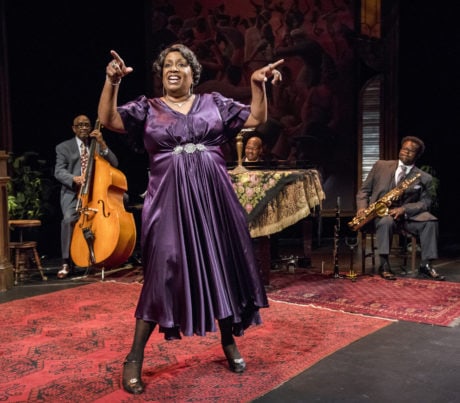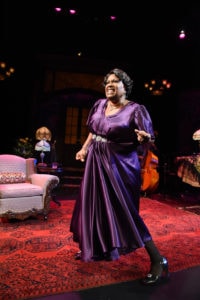It’s no coincidence that The Devil’s Music – the show that celebrates the life and song of Bessie Smith – blew into Washington’s bustling H Street district at roughly the same time that Hurricane Harvey hit Houston.
But while Harvey wrought havoc, this bombastic musical lifts its company, Mosaic Theater of DC, into a whole new era, justifying its recent naming as Helen Hayes Award-winning Best Emerging Company in the area.

The show is part story-telling, part hootenanny – with lots of audience participation- – and part concert, as Miche Braden, one of the greatest blues singers alive today, belts out song after song, projecting the sound and the glory of her voice all the way up to the rafters. She also shimmies and shakes, drinks gallons of hooch and pantomimes her sexual proclivities without regard to gender. In other words, she’s bisexual, and joyously so.
She’s also deemed an ‘unfit mother’ by her nemesis, ex-husband Jack Gee, who steals her money and wins custody of their son, only to dump the boy into one after another of the homes that served as grim receptacles for unwanted children at the time.
One of the show’s strongest numbers is the lament, “I Ain’t Got Nobody,” sung by Braden with ravishing sorrow over the loss of the child she loved.
Other show-stoppers include a rendition of “St. Louis Blues,” which Braden performs with saxaphonist Anthony E. Nelson, Jr., who literally slithers across the stage, blowing a very phallic sax into the singer’s billowing skirt. (In fact, Louis Armstrong, who played the cornet, actually performed the number with Smith, although not – in all likelihood – as lasciviously.)
The show begins when Braden—calling herself ‘the empress of the blues’ (not a mere queen)—storms onto the stage following an ugly Jim Crow encounter. Told that she and her band can’t use the front door at an all-white theater in Memphis, she refuses to perform. Instead, she heads for a down home jazz club for what is to be the last night of her life. The year is 1937.
The set she steps into is a startling beautiful evocation of a 1930s jazz club – the kind that was still around years later, most notably in Greenwich Village, where I lived in the ‘60s. Set Designer Brian Prather has created a sublimely rococco world, complete with leaded windows, dim electric lights inside gaslight chandeliers, art deco chairs, murals on the walls, red carpets on the floor and a richly patterned tasseled shawl on the piano.
The lighting, like the set, is extraordinary. Red and blue spots cast patterns on the costumes, particularly on the star’s outrageously brassy purple satin dress (created by Costume Designer Pat Doherty), while black lights shadow Bessie in her darkest moments, contemplating loss.

Music apart, The Devil’s Music contains some of the funniest shenanigans around. Braden recounts singing for pennies in childhood, then pantomimes herself, at 18, dancing the “hootchie-cootchie” in a traveling vaudeville show in 1912. Soon, she’s belting out numbers like “Can’t Blame Mama.” By the mid-1920s, she’s one of the richest women in show business.
Under the direction of Joe Brancato, whose name is a household word to New York theatre-goers, Braden is extraordinary as Smith. Every gesture – be it hips, hands or mouth – speaks volumes, although occasionally (as with the lolling tongue) it goes too far. But on the whole, Brancato and playwright Angelo Parra keep things moving along.
Much of the action involves banter with the musicians who, in addition to Nelson, the sax player, include Jim Hankins, the great bass player (who happens to be Braden’s uncle) and Gerard Gibbs, a gifted piano player. Not coincidentally, Braden, Hankins and Gibbs are all from Detroit, home of Motown and plenty of jazz history.
According to Ari Roth, Mosaic’s Founding Artistic Director, The Devil’s Music is meant as a counterpoint to last year’s play, Satchmo at the Waldorf, which starred Craig Wallace alternating between the roles of Louis Armstrong, Miles Davis and a crooked manager. That show was a huge success. But while it was about a musician, it had no music.
The Devil’s Music rectifies that gap. While it is not as strong a play as Satchmo, it is different. As its title indicates, it’s a musical, and a vastly entertaining one at that.
This is a production in which the audience is an integral part of the show. I urge you to see it – and to join the crowd that is laughing, clapping and stomping its feet and singing along with the blues.
A-men.
Running Time: 85 minutes, with no intermission.
The Devil’s Music plays through September 24, 2017 (with a potential extension week through October 1), at Mosaic Theater Company of DC performing at the Atlas Performing Arts Center – 1333 H Street NE, in Washington, DC. For tickets, call the box office at (202) 399-7993 ext. 2, or purchase them online.





